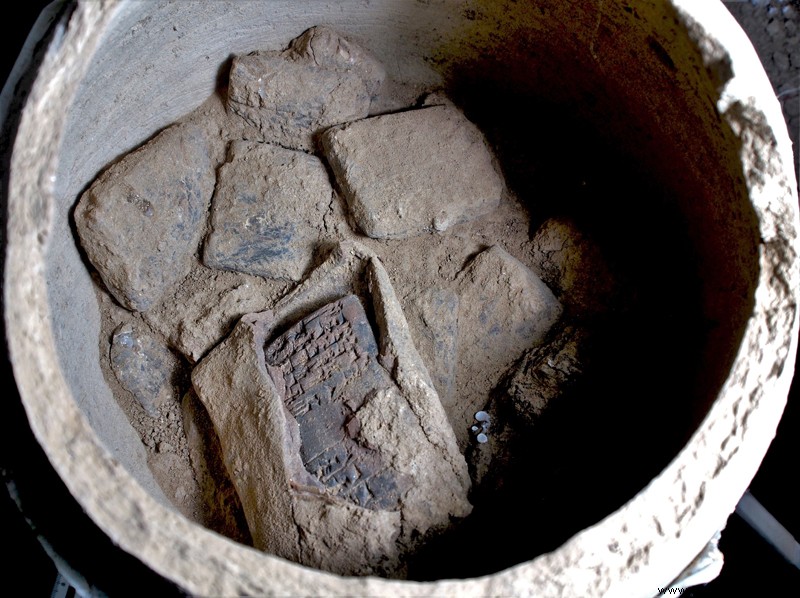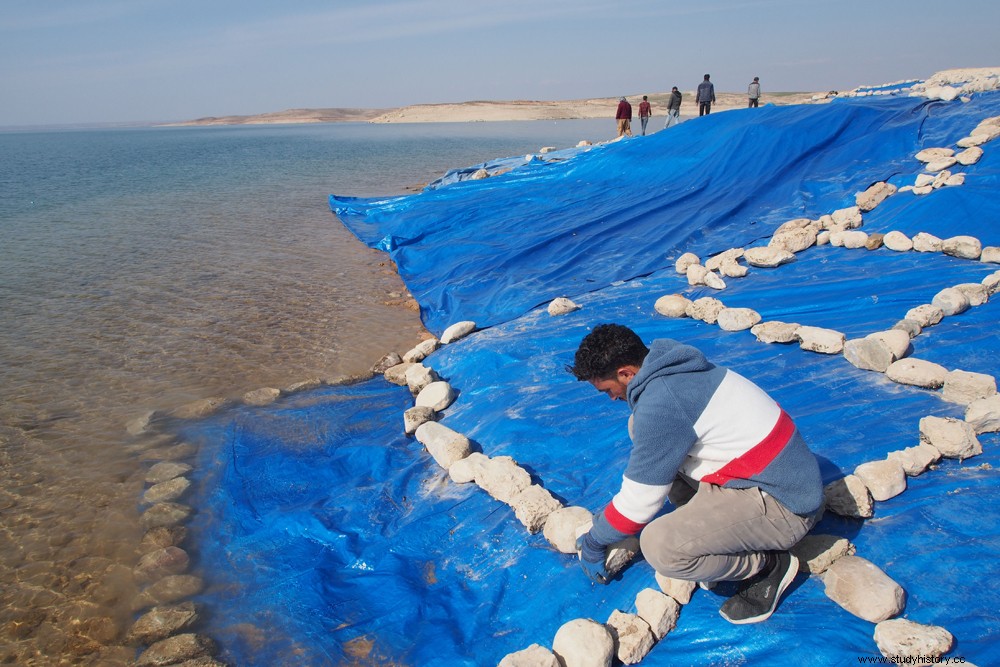Saving ancient heritage is no mean feat in the Middle East. Geopolitical context, traffic, destruction of heritage and climate change pose major challenges to archaeologists. When the opportunity arises to carry out an excavation, it is therefore necessary to know how to seize it. As did a German-Kurdish team which was able, in all haste, to carry out salvage excavations of a Mesopotamian site. Normally submerged in the Mosul Dam Lake, it suddenly resurfaced due to drought.

Aerial view of the Kemune excavations in Iraqi Kurdistan showing the architecture of the ancient city of Zachiku, partially submerged in the Mosul Dam Lake.
Irony of climate change:An ancient city that was submerged during the construction of the Mosul Dam in northern Iraq 40 years ago now reemerged earlier this year when sea levels water suddenly dropped. Faced with this unique opportunity, the Kurdish and German archaeologists working in the region urgently formed a search team which hastened to carry out salvage excavations. Their efforts were rewarded with some wonderful discoveries:a fortified urban complex dating from the Bronze Age, when the still little-known Mittani Empire was deployed (c. 16th century BC - c. 1350 BC) , and valuable cuneiform tablets dating back to the Assyrian period.
An ancient Mesopotamian city emerges from the Tigris River in Iraqi Kurdistan
Built in the 1980s under the regime of Saddam Hussein, the Mosul dam is one of the largest structures in the Middle East. Located about 40 kilometers northwest of the city of Mosul in northern Iraq, it retains the mighty waters of the Tigris River, which forms behind this 113 meter high barrier a huge lake with a capacity of over of 12 billion cubic meters. For years, however, the entire region has been affected by drought not only due to climate change, but also to infrastructural problems. The dam lake thus serves as a reservoir, and when, at the end of 2021, it became essential to continue irrigating the fields in the south of the country, large quantities of water were evacuated, to the point to dry it out. An ancient city, which had been swallowed up during the construction of the dam without any prior archaeological research having been carried out, has thus reappeared. In 2018, similar circumstances had already allowed researchers to unearth the first remains of this city located north of the lake, near the village of Kemune, in Iraqi Kurdistan. From their first discoveries, they had surmised that it might be the city of Zachiku, an important center of the Mittani Empire, which dominated much of northern Mesopotamia and present-day Syria. between 1550 and 1350 BCE approximately.

Aerial view of Zachiku Palace unearthed at the Kemune archaeological site in 2018, but remained underwater in 2022. © University of Tübingen
Excavations under the sign of urgency
One might think that this reappearance is a godsend, but this occasion has turned into a real challenge for archaeologists, challenged to organize the financing and implementation of rescue excavations urgently, without knowing when the water from the dam would cover the site. In a joint press release, the Kurdish and German archaeologists who led the research – Hasan Ahmed Qasim, president of the Kurdistan Archeology Organization (KAO), Ivana Puljiz, from the University of Freiburg, and Peter Pfälzner, of the University of Tübingen – are therefore delighted to have nevertheless succeeded, in January and February 2022, in unearthing new buildings and mapping the city.
A large-scale urban complex
Irony of climate change:An ancient city that was submerged during the construction of the Mosul Dam in northern Iraq 40 years ago now reemerged earlier this year when sea levels water suddenly dropped. Faced with this unique opportunity, the Kurdish and German archaeologists working in the region urgently formed a search team which hastened to carry out salvage excavations. Their efforts were rewarded with some wonderful discoveries:a fortified urban complex dating from the Bronze Age, when the still little-known Mittani Empire was deployed (c. 16th century BC - c. 1350 BC) , and valuable cuneiform tablets dating back to the Assyrian period.
An ancient Mesopotamian city emerges from the Tigris River in Iraqi Kurdistan
Built in the 1980s under the regime of Saddam Hussein, the Mosul dam is one of the largest structures in the Middle East. Located about 40 kilometers northwest of the city of Mosul in northern Iraq, it retains the mighty waters of the Tigris River, which forms behind this 113 meter high barrier a huge lake with a capacity of over of 12 billion cubic meters. For years, however, the entire region has been affected by drought not only due to climate change, but also to infrastructural problems. The dam lake thus serves as a reservoir, and when, at the end of 2021, it became essential to continue irrigating the fields in the south of the country, large quantities of water were evacuated, to the point to dry it out. An ancient city, which had been swallowed up during the construction of the dam without any prior archaeological research having been carried out, has thus reappeared. In 2018, similar circumstances had already allowed researchers to unearth the first remains of this city located north of the lake, near the village of Kemune, in Iraqi Kurdistan. From their first discoveries, they had surmised that it might be the city of Zachiku, an important center of the Mittani Empire, which dominated much of northern Mesopotamia and present-day Syria. between 1550 and 1350 BCE approximately.

Aerial view of Zachiku Palace unearthed at the Kemune archaeological site in 2018, but remained underwater in 2022. © University of Tübingen
Excavations under the sign of urgency
One might think that this reappearance is a godsend, but this occasion has turned into a real challenge for archaeologists, challenged to organize the financing and implementation of rescue excavations urgently, without knowing when the water from the dam would cover the site. In a joint press release, the Kurdish and German archaeologists who led the research – Hasan Ahmed Qasim, president of the Kurdistan Archeology Organization (KAO), Ivana Puljiz, from the University of Freiburg, and Peter Pfälzner, of the University of Tübingen – are therefore delighted to have nevertheless succeeded, in January and February 2022, in unearthing new buildings and mapping the city.
A large-scale urban complex
The city of Zachiku once towered over the Tigris. As archaeologists had anticipated as early as 2018, when they discovered the remains of a magnificently landscaped palace which at the time sat on a hill, it was a large-scale urban complex. This is confirmed by the new buildings unearthed this year:a fortification consisting of a massive wall and towers, an industrial complex and, above all, a storage building rising over several floors, which the researchers describe as "monumental" . The dimensions of this store indeed suggest that an immense quantity of goods was housed there and that it could serve as a regional storage center, which would prove the importance of the site.

Excavation of the walls of a large building, interpreted as a storage building from the Mittani period. © University of Friborg / University of Tübingen / Kurdistan Archeology Organization (KAO)
The Mittani Empire
In the second millennium BC, the Mittani empire was an important factor of power in the region between the Tigris and the Euphrates, corresponding to Upper Mesopotamia. Between the 15th century and the middle of the 14th century BCE, it stretched from the Mediterranean coast to the northeast of present-day Iraq. It is assumed that the heart of this great empire was in present-day northeast Syria, although its capital, Washuganni, has not yet been located with certainty.
We know thanks to the Amarna letters – famous cuneiform tablets, mainly written in Akkadian, found on the site of Tell el-Amarna (the ancient Akhetaton) in Egypt – that the kings of Mittani then acted on an equal footing with their rivals:the Egyptian pharaohs and the great Hittite and Babylonian kings. The Mittanian King Tushratta even gave his daughter in marriage to Pharaoh Amenhotep III. Around 1350 BCE, however, Mittani lost its political importance and the kingdom gradually fell under the control of neighboring Hittites and Assyrians.
The city was destroyed by an earthquake
As seen in the many photographs taken during the excavations, the buildings at Zachiku were made entirely of earth, which is why archaeologists were amazed to find that the walls made of sun-dried mud bricks may have remained as good condition after 40 years under water. They believe that the buildings found were protected during the earthquake that destroyed the city around 1350 BCE. The upper parts of the buildings that collapsed would thus have preserved the remains that are now excavated.

The walls of the Mittani-era storage building are partially preserved over several meters in height. © University of Friborg / University of Tübingen / Kurdistan Archeology Organization (KAO)
One hundred cuneiform tablets
After its destruction, which occurred while the Mittani Empire was already in decline, the site of Zachiku was occupied by the Assyrians. The researchers found proof of this in the form of five ceramic vessels, which contained around 100 cuneiform tablets. Several of them are still surrounded by their clay envelope. For Peter Pfälzner, this discovery is a miracle, because just like the walls of dried mud, the tablets, made of unfired clay, should have dissolved in the water of the lake.
Some of these tablets could be letters, and scholars hope they will provide information about the late Imperial period and the beginning of Assyrian rule because, due to the sparseness of direct sources, history and l organization of the Mittanian kingdom are very poorly known, although the empire had considerable importance in the ancient Near East.

View of one of the ceramic vessels dating from the Middle Assyrian period (ca. 1350-1100 BCE). It contained cuneiform tablets, including one tablet still in its original clay casing. © University of Friborg / University of Tübingen / Kurdistan Archeology Organization (KAO)
A site to preserve
What a dilemma! Because after noting the good state of preservation of these precious discoveries, the researchers now know that each day spent under water risks damaging the fragile clay walls they have unearthed, and everything it remains to be found. This is why the entire part of the site that was excavated was covered with an airtight plastic sheet, held in place by pebbles. It was high time, because soon the waters of the Mosul dam returned to engulf the ancient splendor of Mittani.

After the research team completed their work, the excavations were covered with plastic film to protect them from the rising waters of the Mosul Reservoir. © University of Friborg / University of Tübingen / Kurdistan Archeology Organization (KAO)
